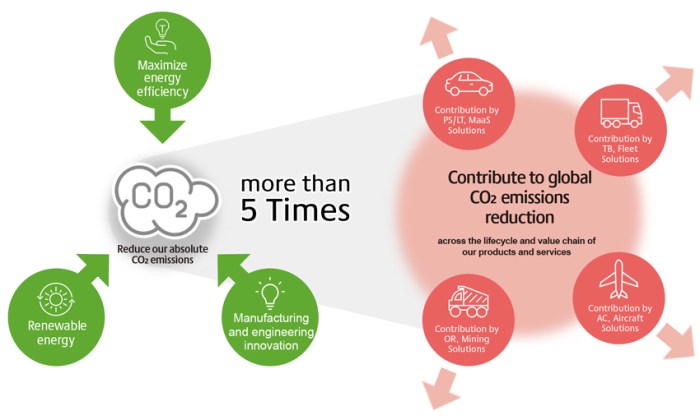How to Reduce Carbon Footprint with Green Energy
How to reduce carbon footprint with green energy is a crucial question for our time. This guide explores the multifaceted ways individuals and communities can lessen their environmental impact through the adoption of renewable energy sources. We’ll delve into understanding your personal carbon footprint, exploring various green energy options like solar and wind power, and implementing practical solutions at home and on a larger scale.
The journey towards a sustainable future begins with informed choices and proactive action.
From calculating your energy-related emissions to understanding the benefits and challenges of different renewable energy technologies, we aim to equip you with the knowledge to make impactful changes. We’ll also examine government policies, carbon offsetting, and the larger-scale transition to a renewable energy grid, painting a comprehensive picture of the path towards a greener world.
Understanding Your Carbon Footprint

Source: bridgestone.com
Understanding your carbon footprint is the first step towards reducing your environmental impact. It involves identifying the sources of greenhouse gas emissions associated with your daily activities and quantifying their contribution to climate change. This allows for targeted efforts to minimize your impact and contribute to a more sustainable future. A comprehensive understanding encompasses various aspects of your lifestyle, from energy consumption to transportation choices.
A typical carbon footprint is comprised of several key components. These include direct emissions from sources you directly control, such as home heating and transportation, and indirect emissions from activities further removed from your immediate control, such as the production and transportation of goods you consume. The relative contribution of each component varies significantly depending on lifestyle and location.
Components of a Carbon Footprint
The major components of a personal carbon footprint can be broadly categorized into several key areas. These categories allow for a more precise understanding of where emissions originate and how to effectively target reduction strategies.
- Home Energy: This includes heating, cooling, and electricity use in your residence. The type of fuel used (natural gas, electricity from various sources, etc.) significantly impacts the associated emissions.
- Transportation: This encompasses all forms of travel, including driving, flying, and public transport. The fuel efficiency of your vehicle and the distance traveled are crucial factors.
- Food: Food production, processing, transportation, and consumption contribute significantly. Meat consumption, in particular, has a substantial carbon footprint compared to plant-based diets.
- Goods and Services: The production, transportation, and disposal of goods you purchase contribute to your carbon footprint. Consider the environmental impact of the products you buy and their packaging.
- Waste: Waste generation and disposal, including landfill methane emissions, contribute to greenhouse gas emissions. Recycling and composting can significantly reduce this component.
Carbon Emissions from Energy Consumption
Energy consumption is a major contributor to personal carbon footprints. A significant portion of our emissions stems directly from the energy sources used to power our homes, vehicles, and industries. Analyzing this aspect is crucial for effective emission reduction.
Electricity generation is a primary source of emissions. The carbon intensity of electricity varies dramatically depending on the energy source used for generation. For example, electricity produced from coal has a significantly higher carbon intensity compared to electricity generated from solar or wind power.
| Energy Source | Approximate CO2 Emissions (kg CO2e/kWh) |
|---|---|
| Coal | 1000 |
| Natural Gas | 500 |
| Nuclear | 12 |
| Solar | 45 |
| Wind | 11 |
Note: These values are approximate and can vary based on specific technologies and geographical locations. CO2e refers to carbon dioxide equivalents, accounting for other greenhouse gases.
Environmental Impact of Different Energy Sources
Different energy sources have varying environmental impacts beyond carbon emissions. Understanding these broader consequences helps in making informed choices about energy consumption and reducing our overall environmental footprint.
- Fossil Fuels (Coal, Oil, Natural Gas): Contribute significantly to air and water pollution, acid rain, and habitat destruction through extraction and transportation.
- Nuclear Power: Generates radioactive waste requiring long-term storage and poses risks associated with accidents, although it produces little to no greenhouse gas emissions during operation.
- Renewable Energy (Solar, Wind, Hydro): Generally have lower environmental impacts compared to fossil fuels, although they can have localized effects (e.g., land use for solar farms, impact on wildlife for hydro dams).
Calculating Personal Energy-Related Carbon Emissions, How to reduce carbon footprint with green energy
Calculating your personal carbon emissions related to energy use involves a step-by-step process. While precise calculations require specialized tools, a reasonable estimate can be obtained using readily available data.
- Gather Data: Record your monthly electricity and gas consumption (in kWh and therms, respectively) from your utility bills. Note the type of fuel used for heating.
- Determine Emission Factors: Find the carbon emission factors (kg CO2e/kWh or kg CO2e/therm) for your electricity and gas sources from your utility company or a reputable source like the EPA.
- Calculate Emissions: Multiply your energy consumption by the corresponding emission factors to calculate your emissions in kg CO2e for electricity and gas separately.
- Sum Emissions: Add the emissions from electricity and gas to get your total energy-related carbon emissions for the month.
- Annualize: Multiply your monthly emissions by 12 to estimate your annual energy-related carbon footprint.
Example: If your monthly electricity consumption is 500 kWh with an emission factor of 0.5 kg CO2e/kWh, your monthly electricity emissions are 250 kg CO2e.
Exploring Green Energy Options

Source: com.au
Reducing your carbon footprint requires a shift towards sustainable energy sources. This section explores several green energy options, examining their advantages, disadvantages, and potential for large-scale implementation. We will focus on solar, wind, and geothermal energy, highlighting their roles in a greener future.
Solar Energy Advantages and Disadvantages
Solar energy, harnessing the power of the sun, offers a clean and renewable energy source. Its advantages include a readily available resource, decreasing costs, and minimal environmental impact during operation. However, solar energy’s intermittency (sunlight availability varies), high initial investment costs, and land-use requirements pose challenges. Furthermore, the manufacturing process of solar panels can have environmental implications.
Comparison of Solar Panel Types
Different solar panel types offer varying levels of efficiency, cost, and lifespan. The following table summarizes key characteristics:
| Type | Efficiency | Cost | Lifespan (Years) |
|---|---|---|---|
| Monocrystalline | 18-22% | High | 25-30 |
| Polycrystalline | 15-17% | Medium | 20-25 |
| Thin-Film | 8-13% | Low | 15-20 |
Large-Scale Solar Energy Projects
Several large-scale solar projects demonstrate the technology’s viability. The Bhadla Solar Park in India, for instance, is one of the world’s largest solar power plants, showcasing the potential for massive solar energy generation. Similarly, the Ivanpah Solar Electric Generating System in California, while controversial due to its environmental impact on wildlife, exemplifies the scale at which solar energy can be deployed.
Wind Energy Potential: Onshore and Offshore
Wind energy harnesses the kinetic energy of wind to generate electricity. Onshore wind farms are relatively easier to construct and maintain, but their visual impact and potential noise pollution are concerns. Offshore wind farms, while more expensive to build and maintain due to the challenging marine environment, offer significantly higher and more consistent wind speeds, leading to greater energy generation.
Wind Energy vs. Solar Energy
Both wind and solar energy are renewable and clean, but they differ in reliability and environmental impact. Wind energy is generally more reliable than solar energy because wind can blow day and night, regardless of weather conditions. However, the environmental impact of both technologies varies depending on the specific project and its location. For example, the visual impact of wind turbines is a major concern for some, while the land use requirements of large-scale solar farms are a different type of environmental consideration.
Geothermal Energy Challenges
Geothermal energy utilizes heat from the Earth’s interior. While offering a consistent and clean energy source, its implementation faces challenges. Suitable geothermal resources are not evenly distributed geographically, requiring significant exploration and drilling costs. Additionally, the potential for induced seismicity (earthquakes) near geothermal power plants is a major concern that requires careful site selection and monitoring.
Household Renewable Energy Integration
Consider a hypothetical household aiming for energy independence. They could install solar panels on their roof to generate electricity during daylight hours. A small wind turbine could supplement solar energy generation, particularly during cloudy days or at night. A battery storage system would store excess energy generated during peak production times for use later. Finally, incorporating energy-efficient appliances and practices would minimize overall energy consumption, maximizing the efficiency of the renewable energy sources.
Implementing Green Energy Solutions at Home
Making your home more energy-efficient is a crucial step in reducing your carbon footprint. By implementing various strategies, you can significantly lower your energy consumption and contribute to a greener future. This involves a combination of upgrading appliances, improving home insulation, and adopting energy-conscious behaviors.
Energy-Efficient Appliances and Their Impact
Choosing energy-efficient appliances offers a tangible way to reduce your home’s energy consumption and, consequently, your carbon footprint. These appliances are rated based on their energy efficiency, typically using labels like Energy Star. Switching to these models can lead to substantial savings on your energy bills over their lifespan, alongside a reduced environmental impact.
- LED Lighting: LEDs use significantly less energy than incandescent or even CFL bulbs, resulting in lower electricity bills and a smaller carbon footprint. A single LED bulb can replace several incandescent bulbs, further reducing waste and energy consumption.
- Energy Star Certified Appliances: Refrigerators, washing machines, and dryers with Energy Star certification are designed to use less energy than standard models. Look for the Energy Star label to identify these efficient appliances. For example, a high-efficiency refrigerator can reduce energy use by 20-30% compared to an older model.
- Smart Thermostats: These thermostats learn your heating and cooling preferences and adjust accordingly, optimizing energy use and potentially saving you up to 15% on heating and cooling costs. They often offer remote control and energy-usage monitoring features.
Improving Home Insulation to Minimize Energy Loss
Proper home insulation plays a vital role in reducing energy waste. By preventing heat loss in winter and heat gain in summer, effective insulation minimizes the strain on your heating and cooling systems, leading to lower energy bills and a smaller carbon footprint. This can involve several approaches depending on your home’s construction.Improving insulation can involve adding insulation to attics, walls, and floors.
For example, adding fiberglass insulation to an attic can significantly reduce heat loss during winter. Similarly, installing weatherstripping and caulking around windows and doors prevents drafts and minimizes air leakage. Investing in double or triple-paned windows further enhances insulation. Consider professional energy audits to identify areas needing improvement and to determine the best insulation solutions for your home.
Installing Smart Home Energy Management Systems
Smart home energy management systems provide a comprehensive approach to monitoring and controlling energy usage throughout your home. These systems often integrate with various smart appliances and allow you to track energy consumption in real-time, identify energy-intensive activities, and remotely control appliances. Some systems can even automatically adjust energy use based on your preferences and energy prices.Installing these systems usually involves connecting the central hub to your home’s Wi-Fi network and then integrating various smart devices.
Many systems offer mobile applications for convenient monitoring and control. The cost varies depending on the system’s features and the number of devices included. The potential savings in energy costs can offset the initial investment over time.
Reducing Energy Consumption Through Behavioral Changes
Simple behavioral changes can have a surprisingly large impact on your energy consumption. By adopting conscious habits, you can significantly reduce your reliance on energy-intensive activities and contribute to a smaller carbon footprint.
- Unplug Electronics: Unplug chargers and other electronics when not in use to prevent “phantom loads” – the energy consumed by devices even when turned off.
- Use Natural Light: Maximize natural light during the day to reduce reliance on artificial lighting.
- Wash Clothes in Cold Water: Heating water for laundry consumes a significant amount of energy. Washing clothes in cold water can save considerable energy.
- Air Dry Clothes: Avoid using a dryer whenever possible. Air-drying clothes saves energy and reduces wear and tear on your clothing.
Switching to a Green Energy Provider
Switching to a green energy provider is a straightforward way to reduce your carbon footprint. Green energy providers source their electricity from renewable sources like solar, wind, and hydro power. This means that the electricity you consume comes from cleaner sources, reducing your reliance on fossil fuels.The process typically involves researching green energy providers in your area, comparing their plans and prices, and then contacting your current provider to initiate the switch.
Many green energy providers offer similar plans to traditional providers, ensuring a seamless transition. Check with your local utility company for available green energy options and any associated programs or incentives.
Green Energy on a Larger Scale
Transitioning to a sustainable energy future requires a concerted effort beyond individual actions. Large-scale adoption of green energy necessitates government intervention, innovative infrastructure development, and a shift towards sustainable transportation. This section explores these crucial aspects, highlighting both the challenges and opportunities involved.Government policies and incentives play a pivotal role in accelerating the shift towards renewable energy. Without supportive legislation and financial encouragement, the widespread adoption of solar, wind, and other renewable sources would be significantly hampered.
Government Policies and Incentives for Renewable Energy
Many governments worldwide are implementing policies to promote renewable energy adoption. These include tax credits and subsidies for renewable energy installations, feed-in tariffs guaranteeing a minimum price for renewable energy fed into the grid, and renewable portfolio standards mandating a certain percentage of electricity generation from renewable sources. For example, the United States offers tax credits for solar panel installations under the Investment Tax Credit (ITC), while Germany’s Energiewende policy has heavily subsidized renewable energy development, leading to a significant increase in renewable energy capacity.
These policies create a favorable economic environment, making renewable energy more competitive with fossil fuels. Furthermore, stricter emission regulations and carbon pricing mechanisms, such as carbon taxes, further incentivize the transition away from carbon-intensive energy sources.
The Role of Carbon Offsetting Programs
Carbon offsetting programs provide a mechanism to compensate for unavoidable greenhouse gas emissions. These programs typically involve investing in projects that reduce or remove carbon dioxide from the atmosphere, such as reforestation initiatives, renewable energy projects, or methane capture from landfills. Companies and individuals can purchase carbon credits, representing a verified reduction in emissions, to offset their own carbon footprint.
While carbon offsetting is not a substitute for reducing emissions at the source, it can play a supplementary role in achieving net-zero emissions targets. The effectiveness of carbon offsetting programs, however, depends heavily on the quality and verification of the offset projects, and concerns remain regarding the potential for “greenwashing” – misleading consumers about the environmental impact of their actions.
The voluntary nature of many offsetting programs also presents a challenge to achieving significant emissions reductions.
Large-Scale Renewable Energy Infrastructure Development
Developing large-scale renewable energy infrastructure presents significant logistical and engineering challenges. Different approaches exist, each with its own advantages and disadvantages. For instance, concentrated solar power (CSP) plants utilize mirrors to focus sunlight onto a receiver, generating heat to produce electricity. This technology is particularly suitable for regions with high solar irradiance and abundant land. Conversely, offshore wind farms harness the stronger and more consistent winds found over oceans, though they require substantial investment in specialized infrastructure and pose challenges related to marine environments.
Hydropower, utilizing the energy of flowing water, is a mature technology but often faces environmental concerns regarding dam construction and its impact on ecosystems. The optimal approach depends on geographical factors, technological advancements, and economic considerations. A diversified approach, incorporating a mix of renewable energy sources, is often considered the most robust and resilient strategy.
Sustainable Transportation Systems and Carbon Emission Reduction
The transportation sector is a major contributor to greenhouse gas emissions. Transitioning to sustainable transportation systems is crucial for reducing carbon emissions. This involves promoting electric vehicles (EVs), investing in public transportation networks, encouraging cycling and walking, and improving fuel efficiency standards. The widespread adoption of EVs, powered by renewable energy, could significantly reduce emissions from the transportation sector.
However, challenges remain regarding the infrastructure needed to support widespread EV adoption, including the expansion of charging networks and the sourcing of critical minerals required for battery production. Investment in high-speed rail and improved public transport systems can reduce reliance on private vehicles, leading to further emission reductions. Furthermore, policies promoting active transportation, such as cycling and walking, can contribute to both health improvements and emissions reductions.
Challenges and Opportunities in Transitioning to a Fully Renewable Energy Grid
The transition to a fully renewable energy grid presents significant challenges, including the intermittency of renewable energy sources (solar and wind power are dependent on weather conditions), the need for energy storage solutions to address supply fluctuations, and the upgrading of existing grid infrastructure. However, technological advancements in energy storage, such as battery technology and pumped hydro storage, are offering promising solutions.
Furthermore, smart grids, utilizing advanced technologies to optimize energy distribution and demand response, can help integrate renewable energy sources more effectively. The development of advanced grid infrastructure and energy storage solutions represents significant opportunities for economic growth and technological innovation, creating new jobs and fostering economic development. The successful transition will require a collaborative effort involving governments, industry, and research institutions.
Visual Representations of Green Energy Impact
Visual aids can powerfully demonstrate the benefits of transitioning to green energy. By presenting data in a clear and accessible format, we can better understand the environmental and economic advantages of sustainable energy solutions. This section will explore two key visualizations: a comparison of carbon emissions with and without solar power, and a lifecycle assessment of a wind turbine.
Solar Power’s Carbon Emission Reduction
Switching to solar power significantly reduces your carbon footprint. Imagine a household currently using 10,000 kilowatt-hours (kWh) of electricity annually, sourced from a grid heavily reliant on fossil fuels. Let’s assume this grid generates 1,000 grams of CO2 per kWh. This household’s annual carbon emissions would be 10,000 kWh
1,000 g/kWh = 10,000,000 grams, or 10 metric tons of CO2.
Now, imagine the same household installs a solar panel system that covers 80% of their energy needs. Their remaining grid electricity consumption drops to 2,000 kWh. The annual CO2 emissions from grid electricity are reduced to 2,000 kWh1,000 g/kWh = 2,000,000 grams, or 2 metric tons of CO2. The solar panels themselves have a carbon footprint associated with manufacturing and transportation, but this is typically offset within a few years of operation.
The net reduction in CO2 emissions is therefore 8 metric tons annually. This reduction directly contributes to cleaner air and a healthier environment, mitigating the effects of climate change. A visual representation could be a bar graph comparing the 10 metric tons of CO2 from grid electricity to the 2 metric tons remaining after solar panel installation, with the difference clearly highlighted to show the significant reduction.
Wind Turbine Lifecycle Assessment
A comprehensive infographic depicting the lifecycle of a wind turbine would illustrate the environmental impact at each stage. The infographic would begin with raw material extraction (steel, concrete, rare earth elements), highlighting the associated land use and potential for habitat disruption. The manufacturing process would be shown next, including energy consumption and emissions from factories. Transportation to the installation site would be another key stage, accounting for fuel consumption and emissions from heavy-duty vehicles.
The operational phase would emphasize the turbine’s carbon-free electricity generation and its positive contribution to renewable energy targets. Finally, the decommissioning phase would show the responsible recycling and disposal of components, minimizing waste and environmental impact. The infographic could use a circular flow diagram, illustrating the various stages and their respective environmental footprints. Each stage could be color-coded according to its environmental impact, with green representing minimal impact and red representing significant impact.
This visual representation would clearly show that while there are environmental considerations throughout the lifecycle, the overall environmental benefits of wind energy generation significantly outweigh the negative impacts. For instance, the operational phase’s substantial carbon emission reduction could be represented by a large, green segment of the circle, clearly dominating the smaller segments representing other phases.
Last Word
Ultimately, reducing our carbon footprint through green energy is not just an environmental imperative; it’s an opportunity to build a more sustainable and resilient future. By understanding our energy consumption, exploring renewable alternatives, and implementing practical solutions, we can collectively contribute to a significant reduction in greenhouse gas emissions. This guide serves as a starting point for a journey towards a cleaner, greener tomorrow, empowering individuals and communities to make informed choices that benefit both the planet and future generations.
FAQ Resource: How To Reduce Carbon Footprint With Green Energy
What are some simple everyday actions to reduce my energy consumption?
Simple actions include switching to LED lighting, unplugging electronics when not in use, using energy-efficient appliances, and adjusting your thermostat.
How much does it cost to install solar panels?
The cost of solar panel installation varies greatly depending on factors such as system size, location, and installer. It’s advisable to obtain multiple quotes from reputable installers.
Are there tax credits or incentives for installing renewable energy systems?
Many governments offer tax credits, rebates, and other financial incentives to encourage the adoption of renewable energy technologies. Check with your local or national government agencies for details.
What is the lifespan of a typical wind turbine?
The operational lifespan of a wind turbine is typically around 20-25 years, although components may be replaced during that time.
How can I find a green energy provider?
Many utility companies offer green energy options. You can also search online for certified green energy providers in your area.









